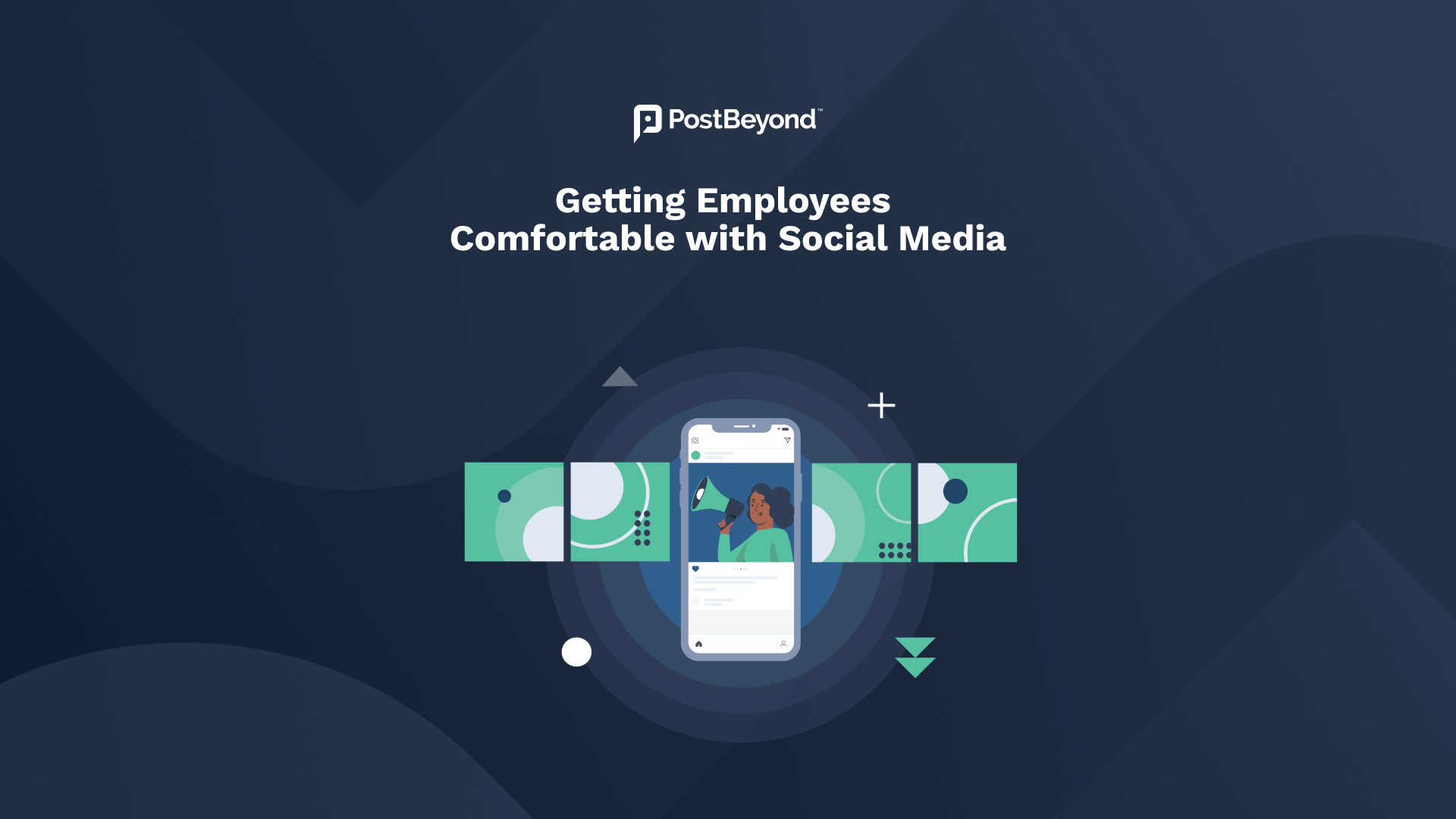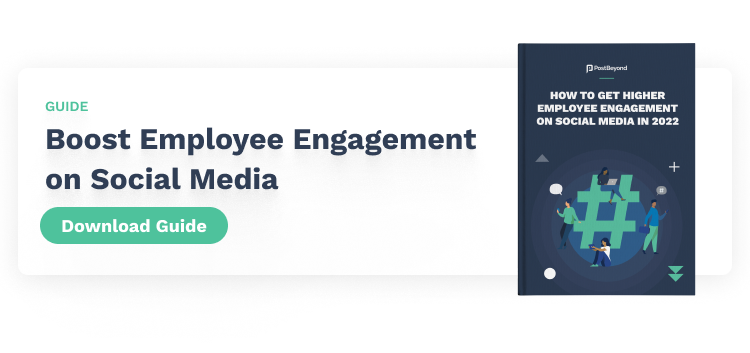In today’s digital climate, engaging audiences is more difficult than ever. People don’t trust ads or corporate marketing as much as their friends and colleagues. Moreover, brands aren’t directly connected to most of their target audiences.
To break through to their audiences, a growing number of companies are looking to employee advocacy. Employees combine for more followers than official social media channels, and they carry the authenticity necessary to resonate with skeptical audiences.
However, many of the brands embarking on employee advocacy asked us, “How do we get our employees onboard?” They want to know how to overcome employee discomfort on social and craft the tools necessary to build a thriving community advocating for their brands.
Our own Sarah Beatty got together with Cristina Simas, NantHealth’s Senior Communications Professional, to learn how her company closed the gap.
Cristina architected a thriving employee advocacy program. She not only engaged employees, but did so in a tough climate full of challenges like being in a highly regulated industry, working with multiple company offices, and getting cross-departmental buy-in.
You’ll want to watch the full webinar to leverage Cristina and Sarah’s strategies, learnings, and upcoming/future tactics. This blog will recap the high level points.

Key Takeaway #1: Create Buy-In Before Starting
Cristina discussed how her team was building buy-in towards employee advocacy activities before actually starting the formalized program.
Using the tools already available to her, such as SharePoint, Cristina built a centralized hub for her employees. This hub served as a supportive resource that gave employees a place to easily find company news, updates, help/guides, and much more.
Employees found the hub useful for both their professional and personal health. Cristina said it was basically an “internal community.” She started seeing employees share approved company content on their social media profiles. In response, Cristina started building a content library in the hub consisting of employee spotlights, Q&As with leadership and more.
In a way, NantHealth was already getting used to employee advocacy activities long before it started its program. By the time Cristina launched the program, she already built a wellspring of people, processes, and assets to drive it.
Key Takeaway #2: Start With the Right Teams & People
Sarah outlined that PostBeyond generally recommends its customers to start their employee advocacy programs with the marketing, sales and executive teams.
These teams have growth-focused metrics that they can reach using social media. They want to generate qualified leads, attract high-quality talent, build brand credibility via thought leadership and more. Moreover, the people in these teams understand that engaging on social is critical to achieving their goals – so they’ll be aligned with employee advocacy.
Cristina took this a step further by engaging these teams directly. By working with their senior managers, Cristina identified advocacy champions in each department. She also built a roster of subject matter experts to help drive content creation. By maintaining touch points across each team, Cristina was able to cast a wide net for feedback, input, and help.
The takeaway here is to make sure you’re leaning on teams that will directly gain from investing their resources into social. You’ll also want people who are enthusiastic about using social from the get-go. Both Cristina and Sarah credit this tight alignment for creating early momentum for new employee advocacy programs. Once you set the “core” team, you can start cascading outwards to other teams and expand your program.
Key Takeaway #3: Eliminate Barriers
Both Cristina and Sarah laid out the need to take a cross-cutting approach for removing the fear, uncertainty, and doubt of engaging on social media.
Start by building or updating your social media policy. Sarah noted how this document enables her customers to mitigate risk and empower employees. It’s a source-of-truth for knowing what your company allows and prohibits on social. It gives employees an accessible starting point to understanding what they can and should be doing online.
The key is to make your social media policy detailed, prescriptive, accessible, and up-to-date with current or emerging social media trends in mind.
You can also leverage pre-built templates and other assets to make it easier for employees to engage on social. For example, you can offer pre-written posts, a list of approved hashtags, or other tips to start your employees on the right foot.
Cristina outlined how she used NantHealth’s content hub to make these resources accessible to her employees. In fact, Cristina noted how the marketing team carefully curates the content to make sure it’s high-quality and safe to post. NantHealth employees feel confident with posting the content. That said, Cristina added that she uses PostBeyond’s flagging and censoring tools to eliminate the risk as much as possible.
Key Takeaway #4: Keep Authenticity Top of Mind
Give your employees content that they can personally relate and speak to. That ‘link’ is very important when trying to carry authenticity. The more your employees can personally get behind the content, the more authentic they’ll be to their audiences.
Sarah recommends building a good mix of content. Don’t just lean on branded content, but maintain a mixture with unbranded content. This can be employee-generated content (EGC) and/or third-party content. Use surveys, regular touchpoints and suggestions to get a feel of what interests your employees.
Top Questions
Do you have tips on showing the value of social media to the executive/leadership team?
Cristina: “The bottom line is that your executive team includes folks from finance, engineering and other departments that may not directly understand your program. They’ll want proof for the things you’re pitching. You’re also competing for budget with other groups in your company. You have to show the financial value. It’s sometimes harder to show the value, but there is a ton of data out there to show the ROI of employee engagement and advocacy. You need a clean deck with data. For me, when I showed the dollar value, it was an easy sell. We’re in a time where more and more people are online, so it makes total business sense to utilize all the tools to get in front of people. People are opting out of ads, so you have to find ways to reach people.”
For employees who “don’t trust” social media, what are your thoughts about using a social amplification platform?
Sarah: “Employee advocacy isn’t meant to be forced. You want to find the right people who are engaged and who want to be sharing. It also comes down to education. So, make sure you’re educating your team through social media policies and other tools so that they understand what they can and cannot share. You should also make it easy for them to share by providing safe content, like pre-written captions.”
How do we get employees to use video more in social media? How do we reduce their fear of being on camera?
Cristina: “We sent people a “Shot on My iPhone” kit with an easy-to-use tripod and ring-light. In fact, there are many other examples of big companies using video right now. We cannot ignore video. So, you can show people how leaders from other companies are shooting videos so they can see what it actually looks like. It makes them more comfortable.”
Sarah: “I would just add that you need the right storytellers. So, if someone is uncomfortable on camera, don’t force them to do something they’re uncomfortable with. Find the people who want to be on camera.”





